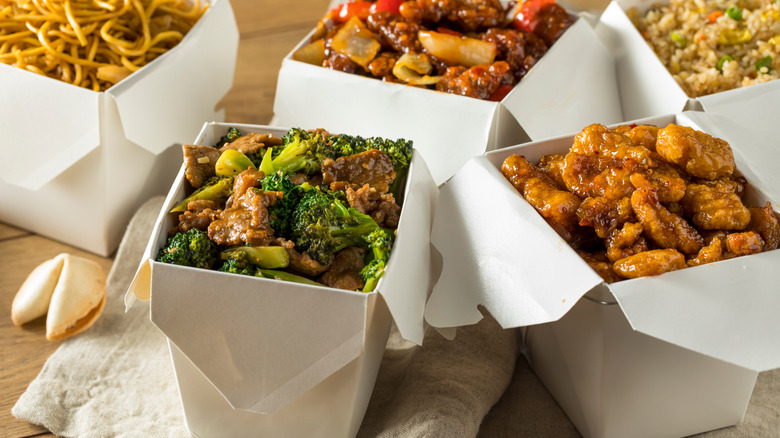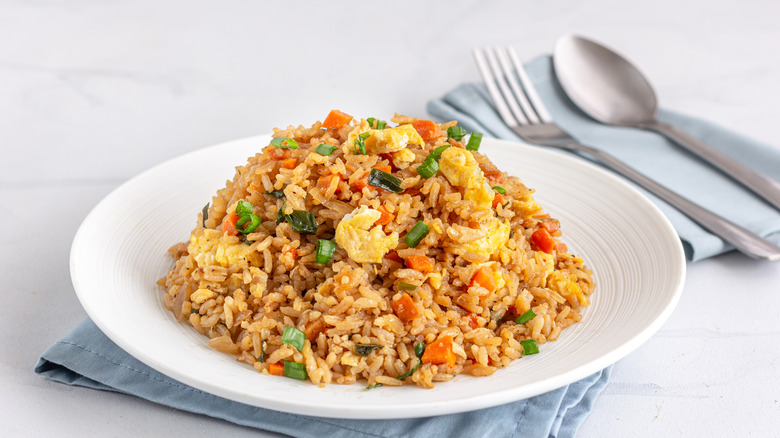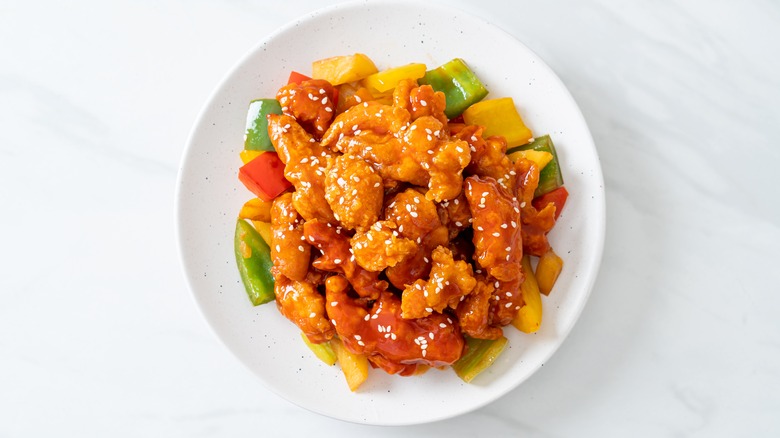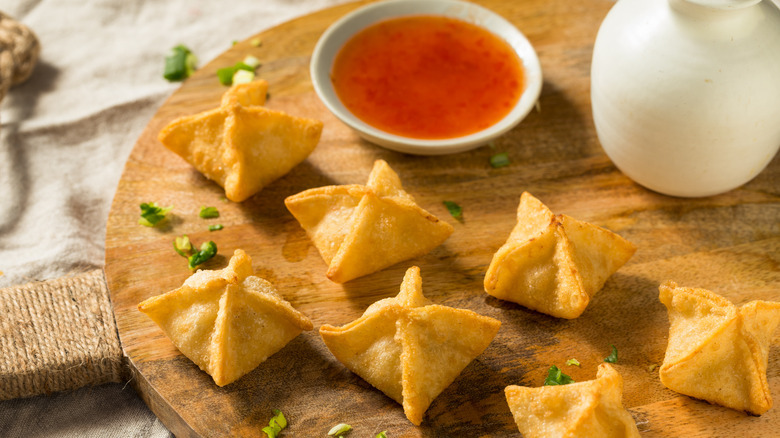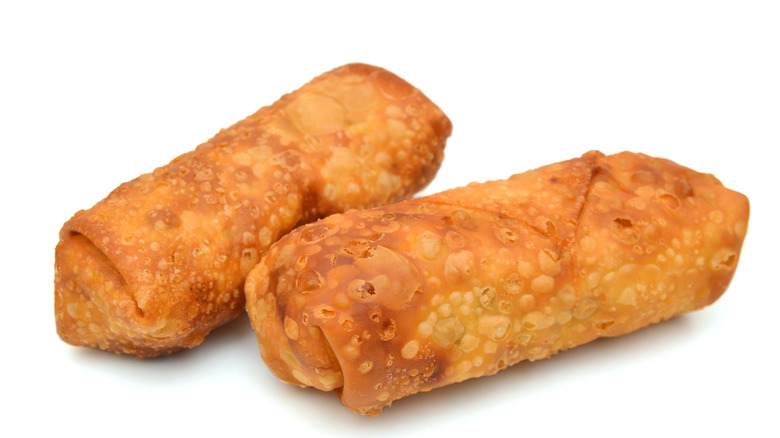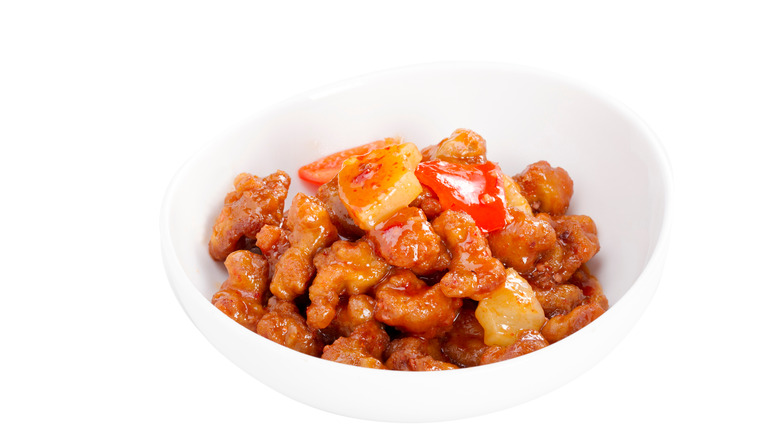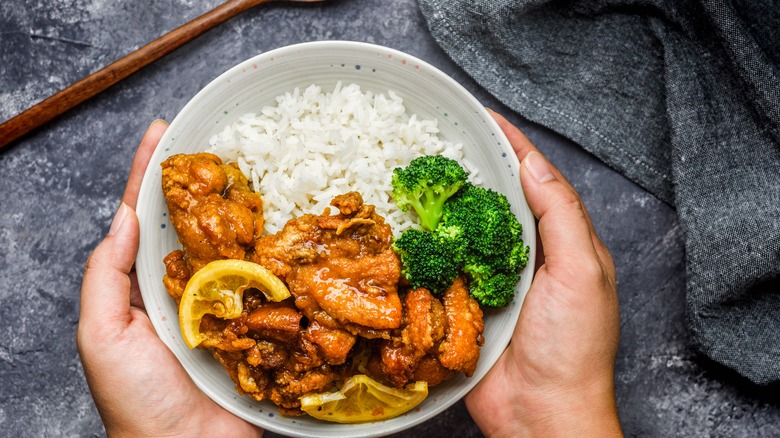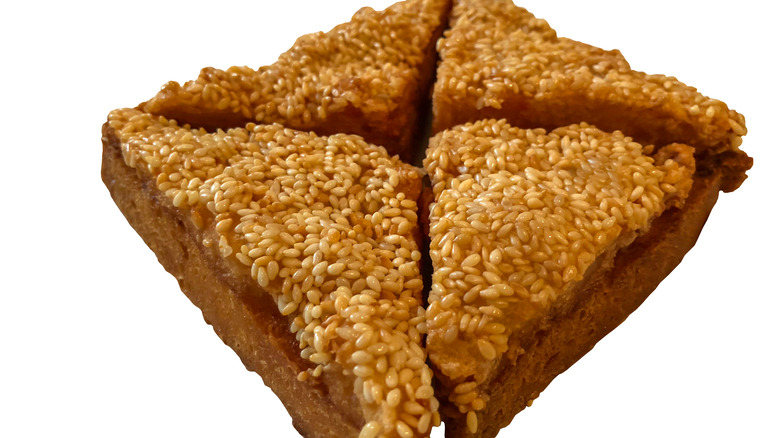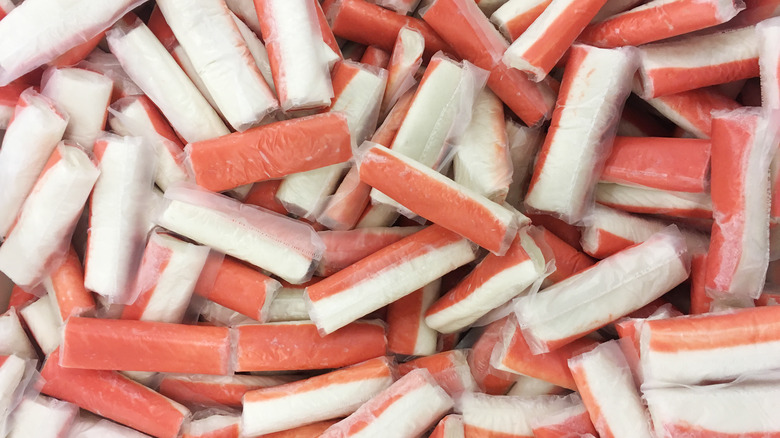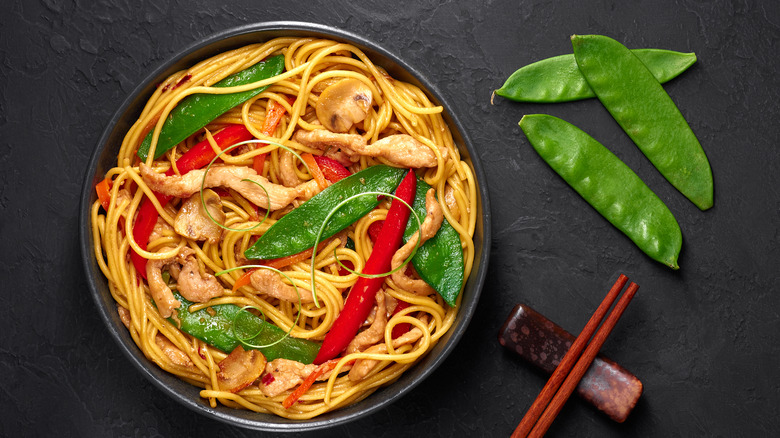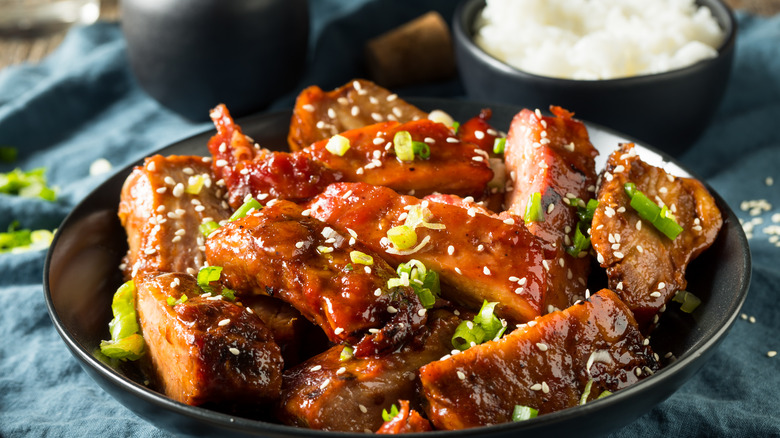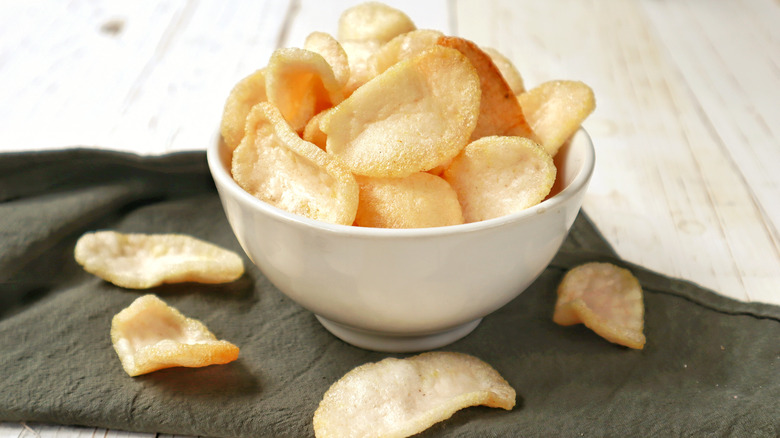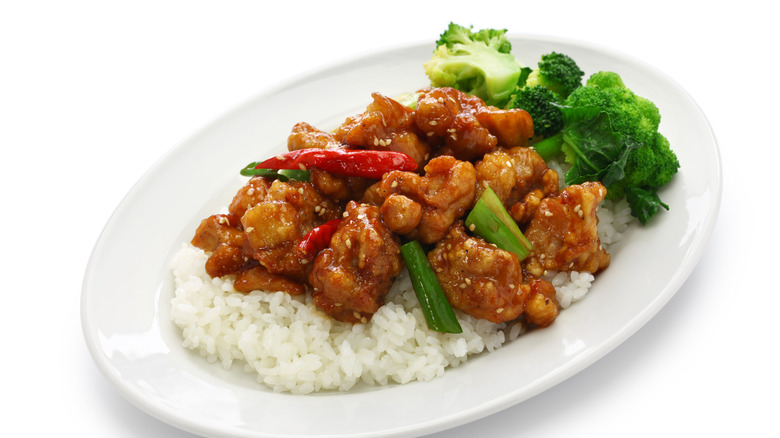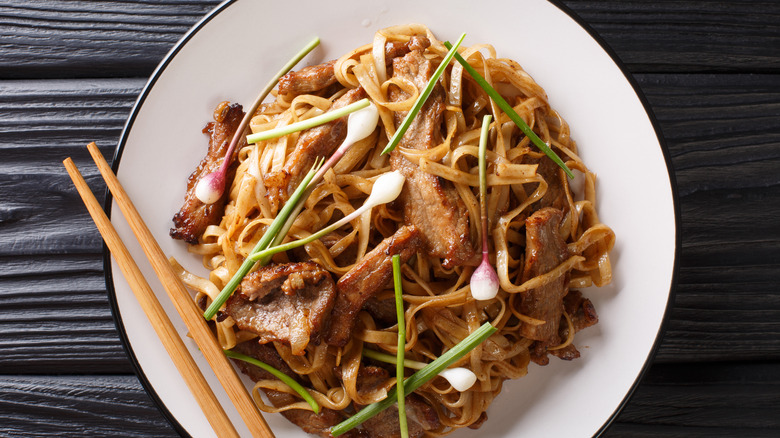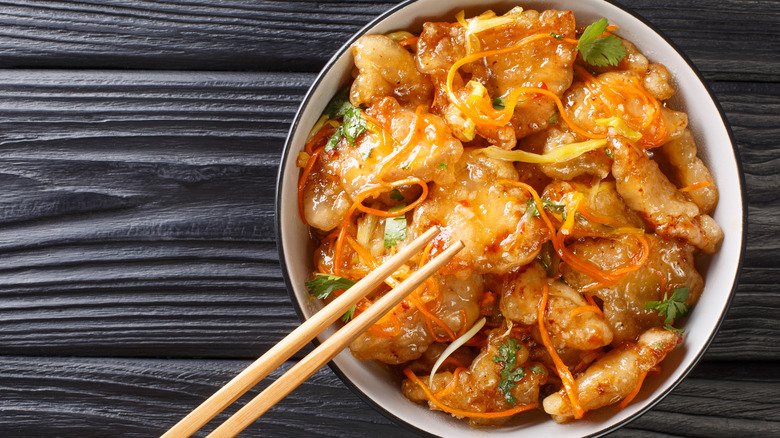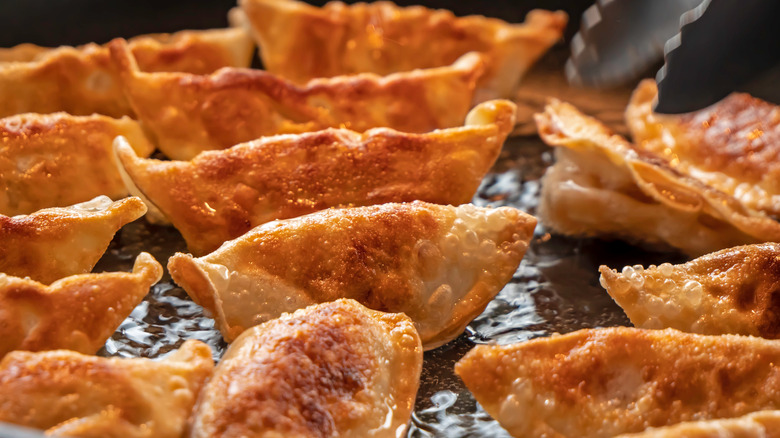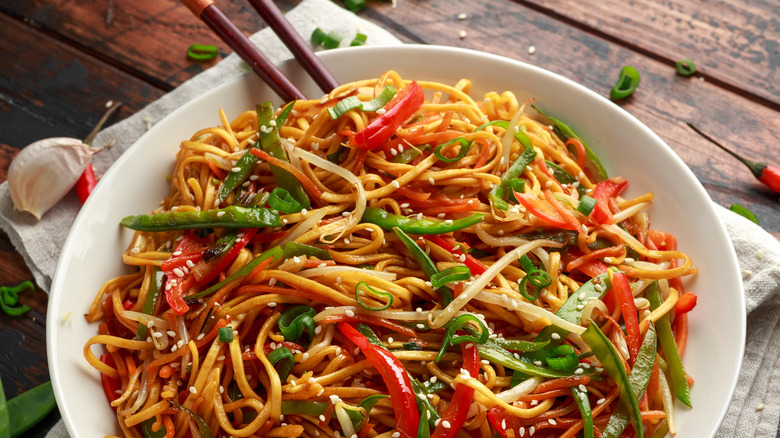Things You Should Never Order From A Chinese Restaurant
It's tempting after a long day at work to take the easy route for dinner and drop some dollars on Chinese food. After all, it's easy, tasty, and you don't have to do the washing up, but although going out for Asian deliciousness is an easy choice when you're tired and hangry, it doesn't come without its risks.
Not all restaurants are created equal, and the same is true for the food they make. In some restaurants, the food on your plate may be indistinguishable from that found on a plate in Beijing, but in others, the food you awkwardly wrangle into your mouth may be about as authentically Chinese as Kentucky Fried Chicken, and have all the health "benefits" to match. So next time you decide to eat with sticks, just remember some things are better left on the menu.
Fried rice
If you are uncertain why this dish is included here, then the clue is in the name. Fried rice is usually made from white rice — which has the lowest nutritional value of any rice option available — which is then thrown in a pan of oil and allowed to soak up the "goodness." This process results in an oily, starchy, undeniably delicious, but totally unnecessary calorie addition to your meal. And when you've just polished off 1500 calories of General Tso's favorite, the last thing you need is several hundred more on the side. Replace the white rice with brown and you gain a little nutritionally, but a little extra fibre doesn't change the fact that it still gets fried.
Calorie counts vary depending on the oil used, but start at around 200 calories for just a cup-sized portion, and only go up from there. Unfortunately, although 200 calories doesn't sound like much, that's for an amount of fried rice that very few people over the age of five can stop at. And if the chef isn't deliberately aiming for health consciousness when he rustles up your order, the calorie count—and your doctor's eyebrows—could easily get much higher.
Sweet-and-sour chicken
Sweet-and-sour chicken is another dish that you probably won't find in China. Sweet-and-sour sauces do exist, but are mostly eaten with fish dishes. And most importantly, the sauce lives in a separate dish which the diner uses for dipping. Travel halfway around the world, and not only does the sauce contain far more "sweet" than it should, but it's hogging the limelight, too. By drowning the (battered and fried!) chicken pieces in the excessively sweet sauce, the amount of sugar you consume goes through the roof. Add in the calories and fat from the batter and frying oil, and you have a recipe for caution.
There are usually some vegetables in this dish, which provides a little more healthy nutrition (not to mention a little illusory weight off your conscience), but they are really only playing a supporting role, and do little to change the numbers. As normal portion can net you over 1700 calories, and over 130 percent of your daily recommended fat ... and that doesn't even include the side of rice. Eat this dish too often and you can include the words "diabetes" and "dentures" on the message in your fortune cookie.
Crab rangoon
Crab rangoon (aka cream cheese wontons, or crab puffs), isn't an entree, which means you order it, chomp it, and forget it. Appetizers are sometimes so small that diners are lulled into a false sense of security. Although one item doesn't necessarily have a lot of bad stuff going on, eat a bunch (and you know you will), and you've got problems. Crab rangoon is basically crab and cream cheese, stuffed into a dough wrapper, and deep fried. Truth be told, it wouldn't really matter what was in the dough when it's deep fried, because that's the culinary equivalent of a mic drop, and not in a good way. Unfortunately, in this case it's (often imitation) crab meat and cream cheese being deep fried, and that's just nasty (tasty, but nasty).
Crab meat can make for a healthy meal, so long as it's not fried, but cream cheese has never been considered the poster child of anything but indulgence, and it's definitely not Chinese. Altogether, you have a pseudo Chinese/American invention that's laden with calories and fat. If you must ensure you're unable to finish your entree, go for spring rolls. Because if you're going to overindulge, you might as well do it with something that's actually Chinese.
Egg rolls
Egg rolls can be just a tasty snack, but more often they play the role of doorman to the calorie palace that is your Chinese meal. Egg rolls seem so insignificant, just a delicious little crispy packet that only takes a couple of bites to consume, but therein lies the problem. Taken on its own, a single egg roll is just a 222-calorie treat ... but they're never eaten on their own, and how many people can just eat one? So start a meal with a couple (ahem, three) egg rolls and you've almost guaranteed that your meal will get filed in the regret column of your morning-after checklist.
On the plus side, egg rolls do typically contain a few grams of protein, which is nice, but since it mostly comes from cheap meat that also contributes to the 11 grams of fat a typical deep-fried egg roll likes to keep around, it hardly makes a convincing case for eating more. If you just have to have egg rolls with your next Chinese meal, try to hold yourself to just one. But since we all know that's effectively impossible, it's probably best to just avoid temptation altogether.
Orange beef
Orange beef is often considered a cousin to General Tso's chicken, and since they both include a sticky sweet sauce, were introduced to American cuisine at the same time, and are both incredibly bad for you, it's not hard to understand why. Not that it's easy to determine how bad this stuff is for you: most nutritional data assumes that a takeaway container contains two servings, but since it's not uncommon for people to order a container full just for themselves, all those numbers should probably be doubled. What this adds up to for orange beef is somewhere in the neighborhood of a frightening 1,200 calories, 50 grams of fat, and 1900 milligrams of sodium.
If you can hold yourself to just half the container, you're probably doing all right. But that also assumes you don't eat any fried rice, egg rolls, or crab rangoon. However, if you're a normal human being who doesn't possess an iron will to resist eating the food you ordered, and you eat everything you're given, as well as a small portion of fried rice and a couple of egg rolls, you might have room for a light beer without going over your recommended calorie limit for the whole day ... but probably not.
Lemon chicken
You might think lemon chicken doesn't sound too bad. After all, chicken is pretty healthy, and lemons aren't exactly famous for their excessive calorie contributions. (We would have noticed the grease floating in our cocktails.) A more accurate name for lemon chicken would be "battered fried chicken in lemony sugar sauce," but it just doesn't have the same ring to it. Check out any recipe for lemon chicken and you'll notice large quantities of oil, sugar, and soy sauce (flavored sodium, by another name), involved in its production. And those are the healthier homemade versions. Farm out the manufacturing to a third party that could care less about your personal health goals, and the numbers go nowhere but up, topping out in the region of 1,500 calories and 75 grams of fat.
And the lemon isn't just lending its name to an unhealthy dish. Its inclusion in the recipe actually helps to disguise the sweet flavors a bit. If lemon chicken were a book, you definitely shouldn't judge it by its cover, nor by its first chapter. Instead judge it by the really big font, the preponderance of pictures, and the greasy fingerprints on every single page.
Shrimp toast
Sure, we've been guilty of imbibing on these delectable little dim sum triangles too. What could be so awful about shrimp and toast? The devil here is not in the ingredients, so much as it is in the preparation.
Shrimp toast is made by taking a light smear of shrimp paste, perhaps blended with scallions, soy sauce, egg and maybe some water chestnuts, spreading it on a thick piece of white bread, and then baking or pan-frying the "toasts." At least, that's how they would be made in a more upscale Chinese restaurant, or if you were making them at home. Order them from your local Chinese take-out, however, and you can almost be guaranteed they will be deep frying the heck out of those shrimp "toasts" in a vat of hot oil. Often, they've been fried so long that they darken to a color resembling pumpernickel bread, soaking up all that oil as they also soak in the flavors of the other deep-fried items on the menu. One piece can set you back almost 150 calories — and considering you typically get 4 or even 8 pieces in an order, we bet you won't eat just one.
Anything with crab
Crab, like lobster, is a pretty pricey ingredient, and one that can fluctuate wildly in price depending on the season, or the harvest that particular year. Yet so many Chinese take-out restaurants seem to have plenty of crab-based dishes on the menu, at reasonable prices. How do they do it?
By serving you imitation crab, of course. Imitation crab, sometimes called crab stick, has been around since the '70s, and is typically made from Alaskan pollock that has been made into a paste, along with starches and sugars, which are molded into a tubular shape and colored to look like crab meat. It's fairly standard in Japanese restaurants too — if you've ever eaten a cheap California roll, you've had imitation crab. Nutritionally, imitation crab meat has less protein than the real stuff, and often contains gluten — so be on the lookout if that's a concern for you. The flavor is definitely crab-like, but the texture, as well as the look of imitation crab is easy to distinguish for anyone who appreciates real crab. Let's consider this kind of crab the "hot dogs of the sea," and move on to a choice that wasn't invented in a factory, shall we?
Lo mein
Lo mein is a popular takeout dish that contains noodles with vegetables, meat, and a soy-based sauce. Order this dish in a traditional Cantonese restaurant and you will be presented with something not far removed from wonton soup and not souper terrible for you. But order lo mein in an Americanized takeaway restaurant and you'll get something not far removed from the garbage, nutritionally speaking. A standard serving of lo mein with your choice of meat can have as much as 1,100 calories, and although there will be a decent amount of protein in there as well, most of the calories come from the carb-heavy noodles and fat, which, assuming you're not a sumo wrestler, will do nothing good for your waistline.
The usual advice in these circumstances would be to do yourself a favor and swap out the oily, salty noodles for a side of steamed rice. But since noodles are the signature ingredient of lo mein, you'll just have to accept that the risk of obesity and heart disease are also signature ingredients ... or eat something else.
Barbecue spare ribs
Spare ribs are not a forgettable snack, and despite what they're called, there are never any spares. Combine delicious, tender, roasted pork with a mouthwatering glaze of salty sweet barbecue sauce, and you have a dish aimed squarely at the stomach of your inner Neanderthal. Unfortunately, just because something sounds good to your personal Flintstone doesn't mean it's good for you.
About the only positive thing that can be said about spare ribs (other than the taste) is that they are a good source of protein. However, that protein comes from pork, which rarely goes anywhere without a whole bunch of fat, and in the case of spare ribs that fat explains most of the 950-ish calories you'll probably find in an 8-ounce serving. That same serving will also contain about 1,200 milligrams of sodium, which is so close to your daily recommended amount that, unless you put down your chopsticks after eating your ribs and never look back, you are almost certain to blow way past that limit no matter what else you ordered off the menu. I
Prawn crackers
Prawn crackers, also known as shrimp chips, are delightfully crispy additions to any Chinese meal, and depending on where you are ordering from they can come either as a side dish or as an appetizer in the style of chips and salsa at a Mexican restaurant. Either way, they can easily be described as the ninja of unhealthy foods because they manage to find their way into your mouth without you even realizing.
Prawn crackers are not particularly complex little morsels. They mostly consist of tapioca flour, prawns, and water. But since it's not a microwave that gets them so light a crispy, those ninjas arrive in your mouth armed with fat and sodium. One single cup of prawn crackers contains more than 200 calories, about 550 milligrams of sodium, and 32 milligrams of cholesterol, and you don't get many crackers in a cup. Start snacking on them while you peruse the menu in the restaurant, and without realizing it you can easily consume 400 calories before you even get to the appetizer.
General Tso's chicken
General Tso was a 19th-century Chinese military man, but he was long dead when this dish was invented. And even if he was alive when this American favorite came to be, he probably wouldn't like it. General Tso's Chicken started out life in the Hunanese style, sporting several traditional flavor profiles, none of which was sweet. It wasn't until the inventor of GTC, Peng Chang-kuei, opened a restaurant in New York, that he added sugar to make the dish more appealing to Americans. Adding sugar didn't help this recipe very much (apart from the flavor, obviously), but it's not like it was a diet option to begin with, anyway. How could it be, when you have battered and fried meat (and sometimes a few vegetables) covered in a sticky-sweet sauce that contains a bunch of sugar and soy sauce?
Polish off a standard portion of General Tso's, and you could have put away over 1,500 calories. All that stuff might be ideal for a 19th-century fighting soldier, but that's not you, so don't eat it.
Chow fun
Chow fun is a Cantonese stir fry dish that is typically made with strips of beef, thick rice noodles, scallions, ginger, bean sprouts, and dark soy sauce. Like many other items on the list, it's far from a healthy option with Fast Food Nutrition suggesting that an 8.5 oz portion from Panda Express contains more than 410 calories, 73 carbs, and 1110 mg of sodium or 46% of your recommended daily intake. "The noodles are thicker, but they're going to do the same damage to your belly and blood pressure as the lo mein," senior nutritionist for the Center for Science in the Public Interest told Newsweek.
Outside of the health aspect, it can also be difficult to find chow mein in the U.S. that is prepared the traditional way. There are two key aspects to cooking chow mein — "wok hei" and "pow wok." Wok hei translates to breathe of the wok, meaning that the noodles should be cooked in a wok over high heat to create a specific savory flavor component. Pow wok essentially refers to continuously tossing the noodles in the wok without the spatula to prevent the noodles from sticking and breaking into pieces (via The Woks of Life). Unless you're lucky enough to find a restaurant that really knows how to properly prepare this dish, there are better menu options to choose from.
Sweet and sour pork
Sweet and sour pork may be protein-heavy, but the deep fried nuggets of pork drenched in a sugary sauce is far from the healthiest option at a Chinese restaurant. Livestrong reports that a serving of sweet and sour pork can contain up to 1,300 calories per pop, not to mention the sugar and sodium. The brand recommends sweet and sour tofu as a more nutrition-dense alternative, particularly if it isn't deep fried in oil.
Another healthier option to enjoy sweet and sour pork is if it's made with grilled pork rather than fried. It's not to say that you should never enjoy sweet and sour pork, but maybe include some vegetable-heavy sides and split family-size portions with a group to get more variety on your plate. "When you're looking at the best nutrients, go for what looks like a real food," lifestyle coach Tony Small told Stuff.
Fried pork dumplings
It's pretty safe to say that anything deep fried should be enjoyed sporadically whether its from a state fair or a Chinese restaurant. Pork dumplings that are totally deep fried are one of those items. Many dumplings or gyoza are steamed and slightly pan fried, which isn't as bad, but the ones totally submerged in oil are high in cholesterol, sodium, and calories. According to Spark People, about two pork fried dumplings contains more than 300 calories, 50+ mg of cholesterol, 45 carbs, and more than 600 mg of sodium.
In general, the oil from frying ups the fat content of any dish. Dumplings filled with vegetables or lean meat like chicken are a little more nutritious, but pork isn't the healthiest option. They still do contain protein and carbohydrates which are important, but that's about it. Portion control is key and having variety in your diet beyond just eating an entire family serving of dumplings. "Although it depends on the size, aiming for dumplings to be no more than half of your plate is a good idea — and then having vegetables or salad for your other half," Simone Austin, accredited practicing dietitian, told Huffington Post.
Chow mein
Chow mein is another popular staple at Chinese restaurants that often gets misunderstood. Mainly, there is confusion about the difference between chow mein and lo mein, as "mein" loosely translates to noodles. Essentially, lo mein contains noodles that are parboiled and stir-fried, while chow mein noodles are fried after boiling so they are a bit crispy before being added to the wok. By the time the dish comes together, the sauce gives the noodles and slightly chewy texture.
As you might expect, frying the noodles doesn't do them any favors when it comes to nutrition. A serving of this dish from Panda Express has more than 500 calories, and 80 carbs. When you consider the soy sauce that is added in, a tablespoon will add a whopping 880 milligrams to the dish. Don't fret, it doesn't mean you have to swear off chow mein altogether. Livestrong reports that making chow mein at home with lean protein like chicken or tofu, more vegetables than noodles, and low-sodium soy sauce is a much more nutrient-dense (and possibly tastier) alternative to take-out.
